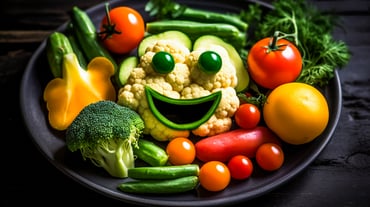6 Nutrition Myths Debunked to Help You Feed Your Family Right
Myth #1: “Children need constant snacks”
While children (and most adults) need 1-2 snacks each day to have enough energy between meals, allowing your children to graze on snacks and drinks all day long will hurt their ability to eat well. Structured meals and snacks allows your children to eat their fill and then go off on adventures, knowing that they will have another chance to eat in 2-3 hours. Children who nibble and sip while they play are often not hungry enough to come to a meal ready to eat and will be less willing to try new foods. Foods that are easy to carry around and graze often include chips, crackers, nuts and sugary drinks. When possible, serve snacks at the table to create that healthy routine and include at least two food groups so the snack is filling enough to last until the next eating opportunity.
Myth #2: “High fructose corn syrup is worse than table sugar”
High fructose corn syrup (HFCS) was created by food scientists to mimic sugar, so the composition of the two is very similar. HFCS has 55% fructose and 45% glucose, while sugar is closer to a 50/50 ratio. They have the same effect on the body. Where HFCS can get your family in trouble is when they’re drinking sodas (which generally contain HFCS) all day long. But the same can be said for the sugar found in lemonade or sweet tea, and even the natural sugars found in fruit juice. Drinking sugary beverages between meals will dull your children’s appetite at meals and snacks and can lead to tooth decay. The better option is to offer child-appropriate portions of sugary foods and drinks at meals and snacks as part of a varied diet.
Myth #3: “Parents decide how much their child should eat”
Children are born with the ability to understand the body’s hunger and satiety cues.* By the time they are grown, societal pressure, busy schedules and dieting have caused many adults to lose this skill. Expecting your children to eat more or less than they want can lead to mealtime battles and cause them to ignore their cues. The parent’s job is to provide healthy food. The child’s job is to decide how much to eat.
Myth #4: “Dark breads are more nutritious than white breads”
We’ve been told for years that brown whole wheat bread is better for our family than white bread. But while whole wheat is more nutritious than refined wheat, the color of the bread is no longer a great indicator of its content. The best way to know what you’re serving your family is to read the ingredients label. Look for breads with 100% whole wheat or whole wheat as the first ingredient. Labels can be misleading when they list wheat flour as the first ingredient because, without the “whole”, wheat usually just means refined white flour. Many manufacturers are even adding in caramel color to trick your eyes into thinking their bread is healthier. Many children prefer the soft texture and look of white bread, so try the new “white whole wheat” products made by companies such as Sara Lee and Nature’s Own, which are made from a wheat variety that lacks bran color, and has a milder flavor and softer texture.
Myth #5: “Bribing with dessert is a good way to get your child to eat vegetables”
Bribing, and pressure of any kind, usually has the opposite outcome than we intended. Bribing your child with dessert if he’ll eat his vegetable teaches him that dessert is yummier than vegetables, so why would he want to eat those? Instead, plan the meal to include a variety of foods, including a child-size dessert portion if you’d like to include dessert, then allow him to choose what to eat from the meal. Be a good role model by preparing vegetables in ways that you enjoy and eating them at the meal. And don’t stress if he refuses to eat many of the vegetables you prepare. Children often find vegetables strong-tasting, and it takes kids a while to learn to enjoy them. Fruits have many of the same healthy qualities as vegetables, including fiber, vitamins and minerals, and are often more appealing to young taste buds. While we want our children to enjoy both fruits and vegetables, this is a work in progress, so in the meantime make sure to include fruits often and keep offering those vegetables.
Myth #6: “Fresh Fruits &Vegetables are more nutritious than frozen”
Frozen fruits and vegetables are flash frozen at their peak of ripeness, just hours after they were picked. Compare this to the many fresh produce options we can find in the supermarket that travel thousands of miles to reach us in their off-season. Think asparagus in the fall, tomatoes in the winter and apples in the spring. Your best bet is to include fruits and vegetables in a variety of preparations – fresh, frozen, canned, dried. All options will provide you with the fiber and nutrients our bodies need. Consider expanding the ways you prepare produce to make them more appealing and exciting for your family. Some of my favorite ideas include strawberries with whipped cream, raw vegetables with ranch dip, and broccoli with cheese sauce.*Children, Infants, and toddlers with certain medical histories and significant feeding challenges may not detect their own body cues for hunger or satiety for a number of reasons. If you are concerned about your child’s feeding challenges, he is not gaining weight, she is losing weight or there is significant food refusals, intervention from the feeding and nutrition specialists at Carolina Pediatric Therapy can help.
6 Nutrition Myths Debunked
Andra Sylvanus, MS, RD, LDN
Want to know how a Therapist can Help?
Call (828) 398 0043 or click on the schedule button.



